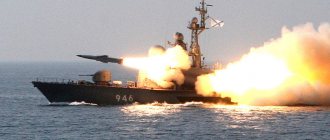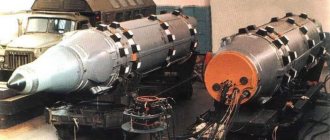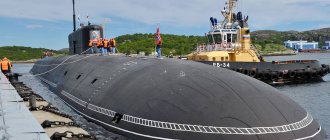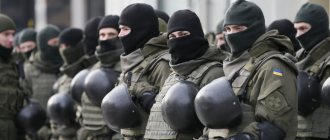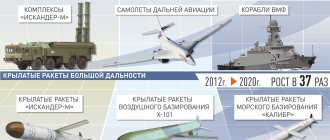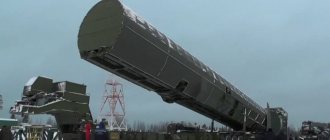The ICBM is an impressive human creation. As a rule, missiles of this class are equipped with nuclear warheads and are used to destroy strategically important enemy targets located on remote continents and long distances.
In the case of long launch ranges, the payload of an intercontinental ballistic missile goes into outer space over a huge distance (hundreds of kilometers). The rocket rises into a layer of low-orbit satellites, which is more than 1000 km above the Earth and is located among them for a long time, only slightly lagging behind their overall run. Then the rocket begins to roll down along an elliptical trajectory.
Thermonuclear power, enormous size, a column of flame, the menacing roar of the launch and the roar of the engines. But all this exists only on earth and then in the first minutes of launch. Then the rocket ceases to exist. Further into the flight and to complete the task, only what remains of the rocket after acceleration, that is, its payload, is spent.
What kind of load is this?
A ballistic missile consists of 2 main parts - the booster (the first) and the other, for the sake of which the boost was actually started. The second part consists of several large multi-ton stages, which are filled with fuel and have an engine underneath (each has its own). They give the necessary direction and speed to the movement of the rocket head. The booster stages, constantly replacing each other, accelerate this warhead towards the area of its future target.
The head of a rocket is a complex load consisting of many elements. It contains a warhead (or several), a platform where these warheads are located along with other components (like enemy missile defenses and radar deception devices), and a fairing. In addition, the head part contains compressed gases and fuel. The entire warhead will not fly to the target. It, like the ballistic missile itself, will be divided into many elements and will cease to exist as a single whole. The fairing will separate from it not far from the launch area, during the operation of the second stage, and will fall somewhere along the way. The platform will collapse upon entering the air of the impact area. Only elements of one type will reach the target through the atmosphere. Warheads. Up close, they look like an elongated cone 1-1.5 meters long, with a base the size of a human body. The nose of the cone is slightly blunt or pointed. This cone is a special aircraft whose main task is to deliver weapons to the target. We'll come back to warheads later and talk about them in more detail.
Design and capabilities of "Topol"
RT-2PM is a three-stage solid-fuel ICBM with a sequential arrangement of stages. Uses solid mixed fuel. Each of the three stages has a solid propellant engine with one fixed nozzle. The first stage contains rotary gas-jet and aerodynamic rudders. It is also equipped with a separate stage for launching the warhead.
TASS/RF Ministry of Defense
The “Topol” launch is from a transport and launch container, “mortar”, using a powder pressure accumulator: the rocket is “fired” from the container, after which the first stage engine starts. Pre-launch preparation and launch operations are fully automated. The control system is autonomous inertial.
The complex patrols the square along roads of various categories. “There must be a dense network of roads for it. If there are few roads, then its survivability will decrease. Therefore, it is necessary that there be a density of these roads in area,” Dvorkin emphasizes.
And we must keep in mind that he does not move all the time; he usually stands either in “Krons” (stationary light shelters) at permanent deployment points, from where he can leave on alarm, or at field starting positions. It mostly stands, but periodically changes its position, since the enemy can detect it from space or in another way. Vladimir Dvorkin Doctor of Technical Sciences, Professor, Major General
During operation, the rocket is placed in a sealed transport and launch container 22.3 m long and 2 m in diameter, in which constant temperature and humidity are maintained. The launcher is located on a MAZ-7912/7917 vehicle chassis.
Expand
The missile system also includes a mobile combat control command post
© Bogdan Rudenko/Russian Ministry of Defense
The complex is capable of fording rivers 1.1 m high. The launcher can be transported on pontoons. “Yes, a certain area must withstand a certain ground load. I want to say that the specific load of the complex, a special device is made there when the tires are deflated. He is walking on not very hard ground. The specific load is like a person weighing 100 kg pressing on the ground,” says Colonel General Yesin.
The complex can enter a forested area, camouflage itself under the crowns of trees, if its width and the length of the launcher allow it to pass between these trees. That is, “Topol” does not require engineering preparation of the area. Viktor Esin, ex-chief of the Main Staff of the Strategic Missile Forces, Colonel General
According to data from open sources, RT-2PM has the following characteristics:
- flight range - about 10 thousand km;
- starting weight - 45.1 tons;
- thrown cargo - up to 1 t;
- combat equipment - one thermonuclear charge with a power of 550 kt;
- accuracy (circular probabilistic deviation) - 150–900 m;
- Dimensions: diameter - 1.8 m, height - 21.5 m.
The RS-12M has two modifications: “Topol-M” - a universal (mine and mobile) solid-fuel missile with a new control system, increased accuracy, larger payload and a new missile defense penetration system; Topol-E is an experimental missile for testing new types of ICBM combat equipment.
Expand
Automatic gyrocompass of the Topol launcher
© Roman Azanov/TASS
By the way, in many photos the Topol complex is often shown only from one side. Dworkin explains this as a common tradition, "because on the other side there is a device that helps provide him with aiming." This system is concerned with determining the location of the launcher after it begins to deploy. “It determines the location of the point, although he reads it as he walks - his heading system also reads. And here - to finally determine your exact location and the exact launch azimuth,” says Esin about the purpose of this system.
For the first time, the Ministry of Defense exhibited “Topol” in its entirety for public viewing at the International Military-Technical Forum “Army-2016”. Along with the autonomous launcher, which is annually demonstrated at the Victory Parade, spectators were able to see the launch battery of the missile system, including a combat control vehicle, a combat duty support vehicle and communications systems.
There have often been many conjectures and assumptions about the name of the complex, why suddenly “Topol”. General Esin commented: “All experimental design work (R&D) carried out by the military-industrial complex is consolidated into a single code, and each time the machine randomly selects a name, and it is then approved. “Topol”, “Yars” - some are trying to tie it to something, but in fact this is the name of the OCD, a code that is set so that it is possible to communicate in a non-secret manner about this or that OCD, without revealing its meaning, such a name is given.” . At the same time, the factory name is completely different.
Push or pull?
All warheads in a missile are in the so-called breeding stage or “bus”. Having been freed from the fairing, and then getting rid of the last booster stage, the expansion stage carries the warheads, as if to passengers at stops, along their own trajectories, along which the cones will each diverge towards their target.
The combat stage is also commonly called the “bus”, since it is responsible for the accuracy of pointing the warhead to the target point, that is, for combat effectiveness. Its operation and breeding stage is one of the largest sectors located in the rocket.
The dilution step can take different forms. Usually it looks like a wide loaf of bread or a round stump, on which warheads are mounted on spring pushers, points forward. They are located at precise separation angles (manually, on a missile base, using theodolites) and look in different directions, like the needles of a hedgehog, like a bunch of carrots. The platform, bristling with warheads, occupies a gyro-stabilized position in space, specified in space. And at certain moments, warheads are pushed out of it. They are ejected immediately after acceleration and separated from the last acceleration stage. Until this entire undiluted hive was shot down by anti-missile weapons or something on board the breeding stage failed.
But this happened before, at the beginning of the separating warheads. Today the division presents a different picture. If previously the warheads “stuck” forward, now the stage itself is in front and the warheads are at the bottom, with their tops back, inverted. In some rockets, the “bus” itself also lies upside down, in the upper stage of the rocket in a special recess. After separation, the propagation stage drags rather than pushes the warheads. Moreover, it drags, bracing itself with four “paws”, which are placed crosswise and deployed in front. At the ends of such paws there are traction nozzles of the expansion stage, directed backwards. After separation from the accelerating stage, the “bus” precisely and precisely sets its movement in the emerging space through its own guidance system. He himself takes the path of the next warhead - its personal path.
Then special inertia-free locks are opened, which hold the next detachable warhead. And not even separated, but simply now unconnected with the stage, the warhead hangs motionless right there, in complete weightlessness.
Sword and Shield Contest
The competition of “sword and shield” – strategic missiles and missile defense systems (ABM) at the turn of the 20th–21st centuries. went with the advantage of the “sword”. It is difficult for missile defense to cope with ICBMs that have received maneuvering warheads with guidance systems on the final leg of the flight. Shield responded with more effective radars, but the ability to intercept modern missiles remains in question.
One of the tasks of the new generation missiles is the ability to overcome missile defense. Even missiles hidden in silos were no longer considered invulnerable, so to increase the survivability of strategic missile systems they began to be made mobile.
One of the options for ICBMs capable of penetrating enemy missile defenses are missiles with multiple warheads (MIRVs) . Such a missile carried not one, but several warheads (BBs), “pushed in different directions.” Then MIRVs with individual guidance . The BBs were installed on an autonomous breeding unit (ARB) with its own engine. The ADB is turned on after the rocket's warhead is launched into orbit, and each AP in turn is launched onto its assigned trajectory and fired. After shooting the last block, the ADB burns up in the atmosphere. This is how the American LGM30G Minuteman III and the Soviet R-36M .
1. ICBM LGM-30G “Minuteman III” (USA, 1970) and its diagram. Length 18.3 m 2, 3, 4. First, second and third stages 5. ABM with warheads 6. Head fairing 7. ADB with warheads 8. R-35M ICBM. THE USSR. 1975 Length 34.6 m Launching a rocket with an ABR: 9. ICBM at the start 10. First stage separation 11. Head fairing separation 12. Second stage separation 13. Third stage separation 14. Operation of the ADB 15. Expansion of the warhead along their assigned trajectories and their shooting 16. ADB burns up in the atmosphere
RS-12 is the first ICBM with a solid propellant rocket engine. USSR, 1968
The strategic missile system R-36M2 "Voevoda" in the West received the code name "Satan". The insidious “Satan” missile is equipped with guided warheads (UBL) , which, after separation from the carrier, move outside the atmosphere not along a ballistic trajectory, but unpredictably shifting due to the thrust of their own rocket engines. After entering the atmosphere, the unit switches to aerodynamic control using special rudders. Energetically maneuvering in the atmosphere, the UBB is practically invulnerable to enemy missile defenses. The unit's radar scans the ground, the resulting radar image of the area is compared with the map entered into the memory of the on-board computer before launch, and the UBB is aimed precisely at the target.
Transport and launch container (TPK) R-36M2 "Voevoda" silo-based. USSR/Russia. 1988 R-36M2 “Voevoda” is listed in the Guinness Book of Records as the most powerful ICBM in the world
The development of systems that prevent radar detection of ICBMs has been carried out in the USSR since the 1950s. The detection range of BBs was reduced by “coating” them with a coating that absorbs radio rays. Together with the BB, they shot at jammers or dipole reflectors - pieces of wire that create numerous flares on the radar screen. The next step was “bubbles” - inflatable LCs (false targets) , similar to foil balloons, hundreds of which were shot together with BB. The enemy wasted anti-missiles on shooting “bubbles” that were indistinguishable from warheads on the radar screen, and in this confusion the warhead’s chance of reaching the target increased. But in the atmosphere, air friction slowed down the light “bubbles” more than the heavy BBs, and, lagging behind, the “decoys” gave themselves away. The rocket could not carry many “heavy” LCs Then they created “quasi-heavy” LCs by installing small rocket engines on false targets, the thrust of which overcame air resistance - this allowed the LC to fly next to the warhead to the ground.
Soviet air defenses could successfully shoot down enemy bombers, and in the 1980s. The United States has developed to replace it the AGM-129 air-launched strategic cruise missile (i.e., launched from the air, from an aircraft), made using stealth technology. The missile was aimed at the target by scanning the area with a laser locator and comparing the resulting “picture” with the one stored in the on-board computer. They wanted to equip all US bombers with the AGM-129 missile, but in the end it appeared only on board the US Air Force veteran - the B-52. After the collapse of the USSR, the Americans put this missile system into reserve.
Air-launched strategic cruise missile AGM-129. USA. 1990
The main problem of early warning radars is their immobility - they always “look in one direction,” blocking a limited sector of possible missile approaches. SBX does not have this drawback . It is installed on a floating platform and can be quickly moved to any part of the World Ocean. If the radar of the American early warning system is directed against Russian ICBMs, then the SBX station can track missile launches of other possible opponents.
, the RT-23 Molodets, a unique camouflage combat railway missile system (BZHRK), was adopted by the Soviet strategic missile forces . It was placed in cars similar to mail, passenger and refrigerator cars, and enemy space or aviation reconnaissance could not distinguish it from thousands of similar trains plying the country's railways. “If something happened,” the train stopped, the roof of the car opened, releasing the ICBM transport and launch container into the light. The coordinates of the starting point and targets were entered into the on-board computer - and having deceived the enemy’s vigilance, “Molodets” was ready to strike a sudden blow. The “Molodets” missiles deceived the enemy missile defense system with ten individually targeted warheads that separated not in strict sequence, but “as if by chance,” and such unpredictable targets were difficult to shoot down. In 2005, the last RT-23 complex was removed from combat duty, and now a new Barguzin BZHRK . RS-26 Rubezh will also receive missiles with maneuvering warheads and excellent camouflage .
Three-car launch module of the combat railway missile system (BZHRK) RT-23 “Molodets”. USSR/Russia. 1989
Mobile complex RS-26 "Rubezh". Russia. First launch in 2011
The power and accuracy of ICBMs grew, and silo launchers could not withstand a direct hit from a nuclear warhead. Therefore, when developing the LGM-118A “Peacekeeper” , the Americans supplemented the silo-based missile with a mobile one – in a train. Wheeled and tracked platforms were also considered, and they even tried to drop ICBMs from a military transport aircraft. However, nothing worked out for the Americans, and the Peacekeepers remained in the mines. the RS-12M Topol mobile strategic missile system , which has been on combat duty since 1985.
RS-12M "Topol". THE USSR. 1985
The modest successes of anti-missile missiles led the military to the idea that the main thing was to see the enemy’s attacking small missiles as early as possible. Then their missilemen will have enough time to launch a retaliatory strike, and the enemy, knowing this, simply will not risk attacking. The Russian missile attack warning system (MAWS) relies on a network of powerful Voronezh-type radars . Another domestic early warning system “Don-2N” (it is part of the Moscow missile defense system) is capable of detecting metal balls with a diameter of 5 cm at an altitude of 350 km and at a range of up to 800 km.
In addition to ground-based radars, the early warning system includes satellites. Their advantage is that they can detect ICBMs at the launch site, while radars see missiles only after they rise above the radio horizon. In 2015, the Tundra satellite , which became the first in the new space warning system.
Delicate movements
The next task of the stage is to crawl away from the warhead as delicately as possible without disturbing its targeted (exposed) movement with gas jets of nozzles. In the event that a supersonic nozzle jet hits a separated warhead, it will make adjustments to the indicators of its movement. Over the subsequent flight time (30-50 minutes, depending on the target range), the warhead will drift from this exhaust “slap” of the jet 500 m - 1 km sideways from the target. It will drift without any obstacles. But is 1 km sideways accurate information in our time?
To eliminate such defects, 4 upper “legs” with engines are required to be spread apart. The stage seems to be pulled forward on them so that the exhaust jets go to the sides and cannot catch the warhead, which is separated by the belly. All thrust is divided between 4 nozzles, which reduces the power of all individual jets. There are some other features as well. For example, if on the donut-shaped launch stage of a Trident II D5 missile the control system detects that the separated warhead is falling under the exhaust of one of the nozzles, it turns off that nozzle.
The stage quietly retreats into space on the 3 remaining nozzles in low thrust mode, while the warhead remains on the target trajectory. Then the “donut” stage with the cross of the traction nozzles is rotated around the axis so that the warhead comes out from under the zone of the torch of the switched off nozzle. Then the stage moves away from the remaining warhead at 4 nozzles, but also carefully at low thrust. Having reached a sufficient distance, the main thrust is activated, and the stage quickly moves into the area of the target trajectory of the next warhead. Then, having reached it, it slows down and again sets the indicators of its movement, after which it separates the next warhead from itself. And this happens until it lands all the warheads on its trajectory. This process is very fast. For example, a combat stage deploys a dozen warheads in 1.5-2 minutes.
Hit from underwater
Successful tests showed: the Soviet Union received a unique new weapon. Now it was necessary to modify it so that missiles could be launched not only on the surface, but also in the submerged position. After all, the main weapon of a submarine is its stealth, and what kind of stealth can we talk about if the submarine has to surface to launch missiles?!
To work out all the details of the underwater launch, TsKB-16 specialists had to create a new test bench - a submersible one. Work on it began in January 1956; in December, the world's first launch of a rocket from under water was carried out from the stand, and then they began testing launches in motion. To do this, it was necessary to build a special submarine, in which the missile launch silos were located... outside! They did it this way: two missile silos were attached to the S-229 torpedo submarine (Project 613) on both sides, and the launch control equipment was placed in the boat itself. This design made it possible to test launches underwater from a depth of 15-20 meters at a speed of 3-4 knots (6-9 km/h). It was not real rockets that were launched, but their mass-dimensional mock-ups: the main task was to understand whether it was even possible to make a rocket launch from under water. It turned out that it is possible!
Now they had to launch a real missile from a real submarine. And again, the B-67 was chosen for this role, which was modified taking into account the results of tests on the S-229, “teaching” how to take water into the launch silos and launch rockets in this position. The first launch, carried out in August 1959, ended in failure, and could have ended in disaster, since after the launch command was given, the rocket remained in the silo and took off only when the boat surfaced and opened the silo lid. By luck, no one was injured either on the B-67 itself, or on the Aeronaut observation ship, or on the ground. The second attempt, made on August 14, 1960, was also unsuccessful: during the flooding of the mine, one of the rocket’s connectors became unstuck, and it was not possible to launch it. And only on September 10, the S-4.7 missile (an experimental modification of the R-11FM) was safely launched from the submarine, which was traveling at a depth of 30 meters at a speed of 3.2 knots. The submarine was commanded at this historical moment by captain of the third rank Vadim Korobov, the former first mate of the B-67.
The naval ballistic missile system based on the R-11FM missile eventually received the D-1 index and was in service with the Soviet Navy until 1967. A total of nine submarines were armed with it: the B-67 and five more boats of the same project, as well as three submarines of Project 629 (the remaining 20 boats of this project received the newer D-2 complex based on the R-13 missile). And I must say, the D-1 complex served very successfully. Over its entire history, more than 80 launches have been carried out, of which over 60 were considered successful - a very good result!
The abysses of mathematics
Above we looked at how a warhead's own path begins. However, if we consider this process in more detail and delve into the topic, we can understand that today the turn in space of the carrier warhead, the deployment stage, is the scope of application of quaternion calculus, where the on-board orientation system processes the indicators of its movement with the continuous construction of the orientation quaternion on board. A quaternion is a complex number, but not with the usual 2 parts, imaginary and real, but with three imaginary and one real. In total, the quaternion has 4 parts, which is what the Latin root quatro says.
The propagation stage performs its work quite low, immediately after the boost stages are turned off (at an altitude of 100-150 km). It is worth noting that there is also the influence of gravitational anomalies on the Earth’s surface, heterogeneities in the even gravitational field that surrounds the Earth. They came from uneven terrain, occurrence of porosities of varying densities, mountain systems, and oceanic depressions. Moreover, gravitational anomalies either slightly release the step with additional attraction or, conversely, attract it towards themselves.
In these irregularities, the complex ripples of the gravitational field, the breeding stage must place the warheads with maximum precision. To do this, it was necessary to develop a more detailed map of the Earth's gravitational field. It is better to study the features of a relief field in systems of differential equations that describe precise ballistic motion. These are capacious, large (to include details) systems, consisting of several thousand differential equations with several tens of thousands of constant numbers. In this case, the gravitational field itself at low altitudes in the near-Earth region is considered as a joint attraction of several hundred point masses of various weights, located in a certain order near the center of the Earth. In this way, a more accurate simulation of the Earth's real gravitational field is achieved along the rocket's flight path. The flight control system works more accurately with it.
Robots and drones
The outgoing year will be remembered for increased attention to ground and air unmanned platforms. New drones were demonstrated both at exhibitions and at training grounds. The strategic exercises of the armed forces of Russia and Belarus “Zapad-2021” became one of the illustrations of this trend. During the maneuvers, the "Pacer" drones carried out reconnaissance and hit targets with guided missiles, and the "Forpost-R" UAV hit a ground target with bombs. Two devices are part of the Lastochka complex, which made its debut at the exercises.
Rolling out of the first flight sample of the S-70 “Okhotnik” attack drone with a flat nozzle
Photo: UAC Press Service / RIA Novosti
Also, 2022 has revealed new facets of the use of UAVs. The prototype of the American MQ-25 Stingray drone carried out aerial refueling of an aircraft for the first time in history. The US Navy F/A-18F Super Hornet fighter received about 150 kilograms of fuel. The prototype Boeing Loyal Wingman drone made its first flight in March. The promising device will be able to work in conjunction with manned aircraft. Despite the fact that these are only prototypes, today they show an image of the near future, where unmanned platforms will operate in the same ranks as manned equipment.
Separately, it is worth noting the progress in the development of heavy attack drones. In February 2022, the Russian Ministry of Defense signed a contract for the purchase of an installation batch of Altius heavy attack UAVs. Already in the summer, the defense department announced the first use of weapons from a promising unmanned platform. At the end of the year, Russia rolled out the S-70 “Okhotnik” drone with a flat nozzle. The stealthy UAV became the first Russian aircraft with such a detail. This feature reduces the visibility of aircraft. Observers suggested that after testing the use of a flat nozzle on the S-70, the Russian Su-57 fighter will receive a new part.
Flight without warheads
The launch stage, which was accelerated by the missile towards the same geographical area where the warheads should fall, continues to fly with them. She can't keep up, and what's the point? After the warheads are deployed, the stage does other things, namely, moves away from the warheads, because it knows that its flight will be different from the warheads, and it cannot disturb them. The breeding stage also devotes all subsequent actions to warheads.
After the warheads are separated, other wards are next in line. Many metal pieces scatter to the sides of the step, which in appearance resemble open scissors and objects of various shapes. Durable balloons sparkle beautifully and brightly with the mercury shine of the metallized surface. They are quite large, some of them resemble warheads. They are coated with aluminum plating. The surface reflects the radar signal from afar in much the same way as the warhead body. Enemy ground radars will perceive these inflatable warheads as if they were real. Of course, upon first entry into the atmosphere, these balls lag behind and instantly burst. But before that, they divert the computing power of radars - and the target detection range and guidance of anti-missile systems. That is, they complicate the current ballistic situation. Well, all the celestial weapons moving towards the area of impact, including false and real warheads, balloons, corner and dipole reflectors, this whole flock is usually called “multiple ballistic targets in a complicated ballistic environment.”
Then the metal scissors open up and become additional electrical reflectors - there are many of them, and they perfectly reflect the radio signal of the long-range missile detection radar beam. In other words, instead of the 10 fat ducks he was looking for, he sees a huge blurry flock of sparrows, in which it is difficult to make out anything. Devices of all sizes and shapes reflect different wavelengths.
In addition to this tinsel, the stage can theoretically independently emit radio signals that interfere with the targeting of enemy anti-missile missiles. Or distract their attention to yourself.
Operation of "Topol"
The decree on the adoption of the RT-2PM complex for service was issued on December 1, 1988. New ICBMs were deployed in 1985–1992. The first unit of the Strategic Missile Forces to receive the Topol, the 779th Missile Regiment of the 14th Missile Division in the Mari Autonomous Soviet Socialist Republic (now the Republic of Mari El), began combat duty on July 3, 1985.
Without waiting for it to be put into service, it was decided to begin its deployment. Two regiments were supplied - 18 launchers. And then their number increased: the maximum number was reached in 1993 - 369. Then the number began to decrease as the first complexes were decommissioned, and given that we were within the framework of the START-1 treaty, we had to reduce Viktor Yesin ex-chief of the Main Headquarters of the Strategic Missile Forces, Colonel General
The production of missiles was carried out by the Votkinsk Machine-Building Plant. Self-propelled launchers of the complex were produced in Volgograd.
Expand
Mobile missile system "Topol"
© Bogdan Rudenko/Russian Ministry of Defense
In 1991, the USSR had 288 Topol missile systems. After the collapse of the Soviet Union, three divisions with these missiles ended up on the territory of Belarus and were withdrawn to the Russian Federation. In 1993, the number of complexes in service reached its maximum value - 369 units. Approximately this level remained until the early 2000s, after which the warranty periods for storing missiles began to expire. The initial warranty period was ten years, later it was increased to 25.
Strategic weapons are a type of weapon that takes decades to develop, deploy, and then remain in service for a very long time. This applies to both us and the Americans. Their warranty period ends, then a new extension period begins, and every year or two this period of being on combat duty is extended Vladimir Dvorkin Doctor of Technical Sciences, Professor, Major General
Since 2006, the replacement of Topol with new mobile complexes Topol-M began. By 2022, the RT-2PM complex remained in service with only one missile division - in the Altai Territory. By the way, since 1982, more than 120 test and combat training launches of Topol have been carried out, the vast majority of them successful.
Last segment
But from an aerodynamic point of view, the stage is still not a warhead. If that one is a heavy and small narrow carrot, then the stage is more like an empty, vast bucket with empty fuel tanks, an oversized, streamlined body and a lack of orientation in the flow that is beginning to flow. The step with its wide body responds much earlier to the first blows of the oncoming flow. In addition, the warheads unfold along the flow, penetrating the atmosphere with the least aerodynamic resistance. The step, with its vast bottoms and sides, leans into the air. It cannot fight the braking force of the flow. Its ballistic coefficient - a combination of compactness and massiveness - is much worse than a warhead. It suddenly begins to slow down and gradually lags behind the warheads. However, the flow forces inexorably increase, and at the same time the temperature heats up the unprotected thin metal, depriving it of its strength. The remaining fuel simmers merrily in the hot tanks. Finally, the hull becomes unstable under the influence of aerodynamic load. Such an overload helps to destroy the bulkheads inside. The crumpled body is quickly engulfed by hypersonic shock waves, tearing the stage into pieces and scattering them. The pieces, having flown a little in the condensing air, again break into even smaller fragments. Remaining fuel reacts instantly. Flying fragments of structural components made of magnesium alloys ignite and instantly burn with a bright flash, reminiscent of a camera - it was not for nothing that magnesium was set on fire in the first photo flashes!
Now everything is on fire, everything is covered in hot plasma and shines brightly around in orange. The sailier and lighter parts are blown into the tail, which is stretched along it, and the denser ones go to slow down forward. All burning elements produce dense smoke plumes, although at such high speeds these dense plumes cannot exist due to the monstrous dilution by the flow. But from a distance they are clearly visible. The ejected smoke particles are stretched along the trail of the caravan of bits and pieces, resulting in a white trail visible in the atmosphere. Impact ionization affects the greenish night glow from this plume. Due to the irregular shape of the fragments, their deceleration is very rapid: everything that is not burned loses speed and, at the same time, the incendiary effect of the air. The strongest brake is supersonic. Having stood in the sky and cooled by the high-altitude frosty subsound, the strip of fragments is not visible, it loses its shape and structure, and also turns into a long (20 minutes), chaotic and quiet dispersion in the air. So there is no breeding step.
Checkmate
In 2022, the Russian armed forces received the first Su-57. In January, the aircraft, assembled at the aviation plant in Komsomolsk-on-Amur (KnAAZ named after Yuri Gagarin), was transferred to one of the air regiments of the Southern Military District. This undoubtedly important event was a milestone in the long-term development of the Su-57, but it was overshadowed by another premiere from Sukhoi.
In July, perhaps the main aviation novelty of the year was shown in Russia. The Checkmate single-engine fighter, also known as the Su-75, was dubbed a competitor to the American fifth-generation aircraft F-35 Lightning II, and Rostec noted the export orientation of the aircraft. The general director of the state corporation, Sergei Chemezov, noted that the cost of a Su-75 flight hour will be seven times lower than the cost of operating an F-35. At the same time, the aircraft will be inconspicuous, and its radar will be equipped with an active phased antenna array (AFAR). At the Dubai Airshow, the head of the United Aircraft Corporation (UAC), Yuri Slyusar, announced that KnAAZ had begun construction of several aircraft for testing. For now, we are talking about demonstration models - the aircraft is planned to begin operation in 2023.
Despite the fact that the Su-75 remains on the ground for now, its appearance and prospects were appreciated by, perhaps, all foreign specialized publications. The fifth-generation single-engine aircraft is conceptually similar to the American F-35, so most publications are based on comparisons of the two designs.
Photo: Leonid Faerberg / globallookpress.com
As is tradition, commentators alternated between doubts about Russia's ability to produce the new aircraft and descriptions of the capabilities that would make the Checkmate best in its class. True, potential competitors of the Su-75 have so far been compared only with the declared characteristics of the Russian new product, which did not prevent Aviation Week & Space Technology magazine from including Checkmate among the main achievements of 2022 in combat aviation.
Perhaps the most popular anti-aircraft missile systems in the past year were the Russian S-400 Triumph and S-500 Prometheus. While the former was more often mentioned in the context of international relations and the arms market, the newest S-500 attracted experts with its characteristics. In July, the new system carried out live firing, successfully hitting the target, and already on September 16, Deputy Prime Minister Yuri Borisov announced the completion of state tests and the start of deliveries of the S-500 to the troops.
During a meeting of the Military-Industrial Commission, Russian President Vladimir Putin noted that the S-500 is among the Russian weapons that are superior to foreign analogues. Some foreign publications shared the same opinion, calling the system a challenge for NATO and a threat to pilots of modern stealth aircraft.
However, there was a panacea - The National Interest magazine called the promising American B-21 Raider bomber invulnerable to S-500 missiles. True, the virtual confrontation is based on the characteristics of the S-500, most of which are unknown, and fantasies about the capabilities of the unflying B-21.
In 2022, representatives of the US Air Force announced the creation of two prototypes of the aircraft, which will fly no earlier than 2022
Meanwhile, Great Britain adopted the new Sky Saber air defense system. The new complex replaced weapons that had been in use since the 1970s. British resources claim that the Sky Saber can control 24 missiles, and each ammunition is capable of hitting a target the size of a tennis ball. However, Russian experts noted that even Soviet-designed systems can demonstrate such accuracy.
Speaking about ground equipment, first of all it is worth noting the supply of Armata tanks. By the end of the year, the military can receive 20 T-14 tanks on the Armata platform. At the same time, the vehicles will receive new ammunition. This will be an important milestone in the history of the tank, which has been in development since 2009. After each postponement of testing of the vehicle or its delivery to the troops, foreign experts tried to find reasons why mass production of the Armata was impossible. Probably, the start of operation will provide food for opposite forecasts. Moreover, in 2021 the tank was presented for the first time at a foreign site. The demonstration of “Armata” at the IDEX exhibition in Abu Dhabi can be considered as evidence of progress, because in Russia the car was shown back in 2015.
At the Army-2021 forum, the Russian Ministry of Defense also signed a contract for the supply of Koalitsiya-SV self-propelled artillery units (SPG), but they will begin to be tested next year. Perhaps then testing of equipment on the Boomerang wheeled platform will be completed. In 2022, it became known about successful preliminary tests of the machines, which The National Interest magazine called the weapon of the future.
Ballistic missile proliferation
The world's first ballistic intercontinental missile, named R-7, was successfully tested on August 21, 1957 in the USSR and successfully entered service in 1960. The first American ballistic missile, the SM-65 Atlas, was successfully tested in 1958 and entered service in 1959. Today, such missiles are in service with the United States, Russia, France, Great Britain and China.
Israel, on the issue of having ballistic intercontinental missiles in its arsenal, takes the same position as on the issue of possessing nuclear weapons - it does not deny or confirm the presence of these missiles in its arsenal. Thus, Israel receives a double benefit from the situation: it does not join the international treaty that implies control over the proliferation of missile technologies and at the same time keeps the countries of the world in suspense, since they do not know its real capabilities. But be that as it may, given that Israel has a used three-stage solid-fuel Shavit launch vehicle, countries do not doubt this country’s capabilities to create ICBMs.
It is known that the first two stages of the Shavit launch vehicle are of “combat origin”; the stages of the Jericho-2 medium-range ballistic missile are used in their role. Unfortunately, there is no exact data on the performance of the Jericho-3 rocket. But experts consider it an intercontinental combat modification of the Shavit launch vehicle.
Pakistan, North Korea and India are developing their own ICBMs; the latter conducted the successful first flight test of an Agni-V type ICBM in April 2012. It was expected that it would enter service in 2014. It is also worth noting that the characteristics of non-combat Indian space launch vehicles (for example, GSLV) have long exceeded the mass-energy characteristics required for ICBMs.
The North Korean Taepodong-2 ICBM, which began work on in 1987, according to experts, is considered to have been tested under the guise of the Unha series launch vehicle.
Some observers believe that Iran, through its space exploration program, is creating technologies that will allow it to develop its own ICBMs. For example, the Iranian space launch vehicle Safir-2, when launched along a suborbital trajectory, is capable of delivering a warhead to a distance of 4-4.5 thousand kilometers.
In the 1980s, South Africa, in order to confront the countries of the USSR and the West, with the assistance of Israel, worked on the creation of the RSA-3 ICBM, but after the collapse of the apartheid regime they abandoned the idea of adopting it into service.
The Japanese are indignant over Russian launches of the Bulava ICBM
Against the backdrop of numerous, but generally neutral media publications, the severity of the responses to the event and comments from Japanese readers, users of social networks and the blogosphere is noteworthy. The Russophobic official propaganda of the Japanese authorities and anti-Russian media is bearing fruit.
Comments from Japanese readers
roj
Japan also needs to develop its own strike missiles! There are only enemies around us. But now we are already late.
p51
We need nuclear submarines; without them there is nothing to do in the Sea of Okhotsk! There are a lot of Russian nuclear submarines there. And Chinese submarines “graze” in the South China Sea.
Conventional weapons are not enough for us. It does not have the same capabilities as atomic. It is strange that, having the sixth largest exclusive economic maritime zone in the world, we have not yet acquired nuclear submarines. After all, this economic zone must be carefully protected!
sun
The best defense is an attack. The country must have high deterrent power against the enemy. Japan needs to develop and introduce the latest and most powerful weapons!
mug
Russia is falling apart before our eyes. She is suffering terrible damage from the coronavirus. There are 10 times more infected people there than in Japan. Opposition forces in Russia are on the offensive, and Putin can do nothing about them. Russia will soon disintegrate into separate territories. These launches are Putin's attempt to demonstrate his resilience to the Russian people and the world!
subarasikinihonkoku
Japan is crushed by aggressive surrounding states. We need to use the plutonium produced at nuclear power plants and create our own atomic bomb. Then we will be taken into account!
rhn
It seems that the Russians had problems with these Bulava ICBMs. Several unsuccessful launches were reported, which were immediately considered “conditional”, etc. No, look, they managed it and brought the rocket to completion! Well, all that remains is to pray that all its launches remain training and do not turn into combat ones!
ciu
One can only guess who this “message” is directed to. To us, to China, or is this “New Year’s greeting” to Biden?
yun
Russia is a truly scary country! These launches can be a threat to both America and us. We are allies, so we can get hit on the head with the Mace!
mih
So who is the Russian enemy? It turns out. America and its ally Japan!
mom
Russia's economic power is highly questionable. But they spare no money to strengthen their military power. The country is becoming poorer, unable to bear such a burden. What kind of social stability can we talk about in Russia?
RedGolgo
And Russia and I are going down and down. Shinzo Abe gave them $3 billion for the “northern territories” without receiving anything in return. Shinzo Abe agreed with the strengthening of the Russian military potential in the “northern territories.” And now the Liberal Democratic Party of Shinzo Abe is silent regarding the launches of ICBMs from the Sea of Okhotsk, which is directly close to Japan! What's next?!
4cVp2fWypvOXHPu
Japan is sitting on a powder keg! Premier Suga, finally wake up!
kyumao_kun_2
We need to make a big fuss about these Russian missile launches!
Tatsuo Yagi
Russia, China and North Korea will not be able to scare Japan using such methods. Because we have a faithful partner - American troops stationed on our soil!
These Russian ICBM launches are a kind of test for Biden. Will he give up some slack in his policy?
kunikoasagi
Well, isn't this outrageous? Isn't this a reason to call the Russian ambassador to Japan and express the most decisive protest to him? What if China did the same? I think we'd have a blast! Why are we silent in response to these actions of Russia?
toseibito
Not weak! The strategic nuclear submarine "Vladimir Monomakh" simultaneously launched heavy ICBMs "Bulava" right from under our noses, shot across the entire territory of Russia and ended up in the Arkhangelsk region 5 thousand kilometers away! What is happening!
czQE3kAUyr6DFNA
Again, at best, things will end with our weak protests and “regrets.” Again, we will be afraid to change this pacifist Constitution. We will give Russia money again in the near future. Liberal Democratic Party! Wake up, stop looking away and pretending that these Russian attacks don’t concern you!
Classification of intercontinental ballistic missiles
According to the method of basing they are divided into:
- launched from mobile installations based on a wheeled chassis: “Miji;
- launched from the bottom of oceans and seas from pop-up capsules: “Skif”;
- launched from ground-based stationary launchers: Atlas, R-7;
- launched from silo launchers: RS-20, RS-18, “Minitnem”;
- launched from railway launchers: RT-23UTTH;
- submarine-launched ballistic missiles: Trident, Bulava.
Launching from ground-based stationary launchers ceased to be used in the early 1960s, as it did not meet the requirements for secrecy and security. Modern silos guaranteed a high level of protection from the damaging factors of a nuclear explosion and made it possible to reliably hide the level of combat readiness of the launch complex. The remaining options listed above are considered mobile, and accordingly, they are difficult to detect, but at the same time, they impose serious restrictions on the mass and size of missiles.
Other methods of basing ICBMs were often proposed, which are designed to ensure the security of launch complexes and the secrecy of deployment, for example:
- in ultra-deep rock mines, from which TLCs (transport and launch containers) with missiles must rise to the surface before launch;
- on specialized aircraft and airships with the launch of ICBMs in flight;
- at the bottom of the continental shelf in special pop-up capsules;
- in a network of underground galleries through which mobile launchers move (but such projects were not implemented).
Plans of the Ministry of Defense
On May 30, 2022, from the tender documentation on the government procurement website, it became known that in 2019-2020 the Ministry of Defense intends to conduct at least nine launches of intercontinental ballistic missiles:
- two launches of the Sarmat heavy ICBM (under testing; expected to enter service in 2022);
- three launches of Yars ICBMs;
- four launches of the Topol ICBM.
The Ministry of Defense announced the holding of a closed competition for the purchase of services for insurance of liability for causing harm to the life, health or property of others during space activities for the needs of the department. The document, in particular, indicated the amount of liability insurance for the launch of ICBMs. The cost of insurance for each launch of Topol and Yarsov is more than 295 thousand rubles, for one launch of Sarmat - more than 5.2 million rubles.
Changes were made to the news (12:27 Moscow time) - information about the launch of the Sineva ballistic missile was added.
Indicators
The most important characteristic is the firing accuracy of ICBMs. And this is not surprising, since doubling the accuracy makes it possible to use five times less powerful combat charge. Accuracy is limited only by the accuracy of the navigation system as well as the available geophysical data. Many government programs, such as GLONASS, GPS, Earth remote sensing satellites, are used, among other things, to increase the accuracy of navigation information. The most accurate ballistic missiles have a CEP of less than 100 m, even at intercontinental range.
The maximum flight range is 16,000 km, providing almost global reach for a missile strike, regardless of the location of the launcher. Payload - up to 10 tons, launch weight - 16-200 tons, trajectory apogee - up to 1000 km.
The descent to the target is carried out at a speed of more than 6 km per second. Ground-based flight time from the Russian Federation to the USA varies in the range of 25-30 minutes. Flight time for underwater-based missiles can be significantly shorter and be up to 12 minutes.
Orbital missiles have unlimited range, but were withdrawn from service under the SALT II treaty.
Sea launch
Launches from the rocking stand were carried out in May-July 1955, and at the same time the first Soviet missile submarine was being completed at the shipyard in Molotovsk (present-day Severodvinsk). One of the large torpedo submarines of Project 611, designated B-67, was assigned to this role. It differed from other boats of the same project by its characteristic wheelhouse fence - higher and longer. It was here, behind the wheelhouse, and not in the hull, as is customary today, that two silo launchers for R-11FM sea-based ballistic missiles were located. And the launch itself was also completely different: the rocket rose from the shaft, took a vertical position on the launch pad on top of the wheelhouse fence, and only after that the engines were started.
Shipyard No. 402 (current Sevmash) accepted the boat for completion in the summer of 1954. It took more than a year to turn a torpedo submarine into a missile submarine. Only on September 11, 1955, the Soviet naval flag was raised on the B-67, and it officially joined the Navy. And just four days later, on the night of September 15, two R-11FM ballistic missiles were loaded onto the boat in the strictest secrecy. This was done under the supervision of Sergei Korolev himself. He didn’t just come to the Northern Fleet to follow the fate of his brainchild. The chief rocket scientist of the USSR intended to go to sea and be present at the world's first missile launch from a submarine. He wanted to feel how the boat behaved in the sea, how it plunged and surfaced, in what conditions the crew lived - all in order to take these details into account in the future when designing sea-based missiles.
“Seven missiles were prepared for the first sea tests,” academician Boris Chertok, who, along with Sergei Korolev, was listed as one of the two chief designers of the R-11FM, later wrote in his memoirs “Rockets and People.” – The test and launch launch systems in the marine version “Saturn-M” and “Dolomite” were developed jointly with us and NII-885 by the maritime institutes MNII-1 and NII-10. To monitor the flight, telemetry receiving stations were installed on the shore. Observation and communication were carried out by a special ship. The first launch of the R-11 FM missile from a submarine was made in the White Sea on September 16, 1955. Korolev, together with Isanin (chief designer of TsKB-16 Nikolai Isanin. - Author's note ) personally supervised these tests. Seven launches in the White Sea were successful. At the same time, three missiles were launched after long-term storage. The launches were carried out in conditions of a stationary and moving boat at a speed of up to 10 knots and waves of up to 2-3 points.”
Behind these dry lines is the tension and colossal work that thousands of people did throughout the USSR. For example, the B-67 combat missile crew: 12 people, led by the submarine commander, captain of the second rank Fyodor Kozlov, went on a business trip to the Kapustin Yar training ground back in the fall of 1954. But out of seven launches of the R-11FM from the first rocket boat in the USSR, only one turned out to be an emergency, and the rocket that failed to take off had to be thrown from the boat into the sea (it was later, by the way, never found in a thick layer of thick silt). This, by the way, made it possible to work out the emergency missile release technique: the designers did not rule out the repetition of similar situations on production submarines.



